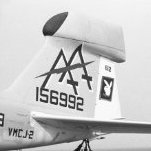
BWDenver
Members-
Content Count
335 -
Joined
-
Last visited
About BWDenver
- Currently Viewing Topic: Another Meteor Productions story............
-
Rank
Tenax Sniffer (Open a window!)

Profile Information
-
Location
Falcon CO
-
Interests
Bird shooting, with camera and gun, target shooting, aviation photography, aviation research, and in the summer riding my Harley Road Glide Ultra, 1/48 modeling - IJN and some others
Recent Profile Visitors
2,935 profile views
-
Probably environmental bleed into the gray. You're prob ably correct on the color.
-
I did a color check on this and it is an interesting color.... Bryan
-
Yup, B-1A 76-0174, should have looked at the caption on the full size shot...
-
OK, I misread that post...
-
B-1B at Edwards in Camo. I was flying into Edward and saw this. Put the stick between my knees and grabbed my 35mm. Couple of quick snaps later.
-
Ah, so they were both LH chute pack install. Bryan
-
I have some shots of the XV-15, but nowhere near as good as your shot! Really nice. You are correct on the chute placement. NAA ran into seat collisions on a low sped test, and on sled test 14 they changed the seats to LH & RH seat configurations to allow for aerodynamic forces to diverge the seat trajectory. The chute placement on the KW-3B installed in the OV-10 is pilot LH chute, Observer RH chute. I take it the XV-15 had the same arrangement, with the RH seat having a RH chute pack? The shot at the NSAS Ames hanger was taken June 1979. I was flyi
-
Quite agree! Nothing beats a blue pint! The doc I have done by Boeing covers a lot of the operational seats, and while it addresses the X-15 seat quite well, it does not have any dims like some of the other seats. An interesting side note, when I reviewed the Aerofax pub on the X-15 and pointed out that the wording about the escape system was "very similar" to the Boeing doc, the only difference being present v past tense, Jay Miller came unglued and sent a really nasty letter to the editor of the IPMS pub. We both had a good laugh over it. Bryan PS, ju
-
LW-3B and the OV-10 Bronco The NAA (North American Aviation) OV-10 was a rather interesting battle between the Airframe and Crew stations folks. The prototype took off on July 16th 1965, and the production OV-10A first flew in August 1967. The original intent for the turbo -prop driven COIN bird was the crew bails out the side of the aircraft. When B.C. Solomonides (Supervisor Crew Stations) became aware of this, he pitched a major fit. “Look at the cockpit, and then the props.” Mr Solomonides helped me with background information on NAA Seats when I was actively re
-
Not sure I can share your thoughts on the X-15 v HS-1 seat. The X-15 seat is a monocoque construction while the HS-1 is truss frame design. I think the X-15 was designed and built on the West Coast v the NAA Columbus Division in OH. I could be wrong on that. I seem to think I saw a shot of the first X-15 being delivered to Edward, on a flat bed. The crew stations team in Columbus did not work on the X-15. B.C. Solomonides (Supervisor, Crew Systems Columbus Div, who I've talked to) worked on the HS-1, and the LW-1 - 3 systems. One of the other Columbus team members
-
Hopefully the info will prove useful for future projects!
-
HS-1, A3J/A-5A-B/RA-5C & HS-1A RA-5C Of all the seat information I have, the North American Rockwell seats are best covered with factory information. I’m fortunate to have the qualification reports and factory proposals for most of their seats. North American in the late 50’s and early 60’s built some truly remarkable ejection seats. They were also not subject to Martin-Baker seat replacement. For simplicity’s sake I will use the final designations of A-5 for RA-5A or 5B and RA-5C The pinnacle was probably the HS-1A, High Speed-1 Improved Performanc
-
Firebee Drone question & DC-130A info & OzMods C-130A conversion
BWDenver replied to BWDenver's topic in Jet Modeling
But it was sealed long before it was replaced with solid structure. Bryan -
We carried two 25 Gal AFFF (light water) tanks back in the gunner wells. Flow went from the left to right side. The 9-18' boom was adjustable, 90 degrees right to 360 degrees straight ahead. We could either use it retracted and dump Stright down or extend it to 18' and spray in a fan patter. It would open a 50' x 100' corridor in the fire. We routinely worked 500 Gal JP4 fires. I did one night fire and when the fire went out it got REAL DARK! The hoist was located on the fwd left side of the cabin, just behind the 22" door. As the hoist was rotated out it opened the door and the fire f
-
Thanks! It shows simple (brute force) Russian design thinking. I wonder why they went down that path and not the MB style nylon garters or even the Spurs of the F-104... It looks like a lot of the aftermarket company's also are lacking the this info. But now folks can include it and get it right. Bryan thanks again.


